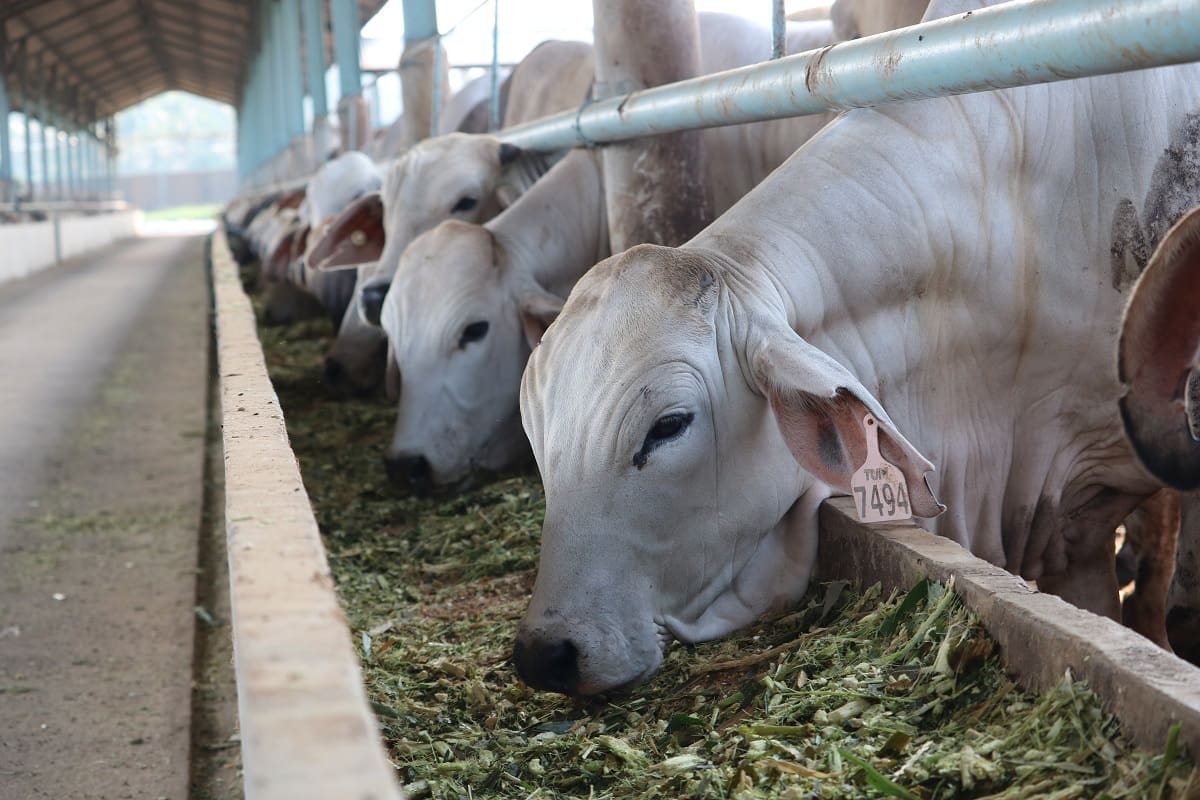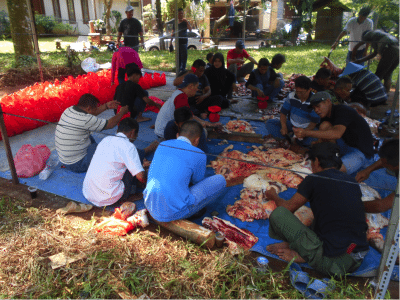
Australian cattle on feed in Indonesia. Nutrien was quoting prices of 420c/kg for Brahman export steers ex Darwin in mid-March but with the sliding market prices have since eased below 400c in the second half of March, according to exporters Beef Central has contacted this week.
Contracted rates for northern live export cattle have fallen by more than 20 percent amid relatively limited trade since Christmas.
From 520c/kg mid-December, current pricing indications are being quoted around 400c/kg liveweight ex-Darwin and lower still given the prevailing supply-demand outlook.
Supply
Supply is set to increase as annual post-Easter mustering programs commence, at least where it still isn’t too wet, while demand from South East Asia remains weak according to reports from exporters and Asian-based analysts.
While supply normally rises at this time of year, not all northern producers with cattle to sell will be feeling pressure to do so.
Many are in a strong position after a good run of years, with money in the bank, a good season and grass to hold cattle if they are not happy with available prices.
It is one reason why some cattle being shipped out of Darwin and Townsville in recent months have been transported from as far away as southern Queensland and northern NSW.
Many of those are high-grade Brahmans that were purchased by southern producers to restock paddocks when cattle were in short supply last year.
In an improved supply environment this year, the export type cattle are in less demand among feedlots in northern NSW/Southern Qld, and are instead being trucked north again where the export market is again proving to be the best market for that category of stock.
Exporter Richard Bond, Bondstock Rural Exporters, said many northern producers were in a strong position and felt they were not under pressure to sell.
He added, though, that the supply situation has “definitely turned” and exporters are now getting offered more cattle that have less options to go to other markets than in the last few years.
“The medium 380-450kg Brahman steers that were going down south for feedlots are now looking to live export markets to find a home,” he said.
“The price feedlots are putting on their grids reflects that they’re not overly interested in them (Brahman export steers) now.”
While more cattle are available, turnoff has still not yet reached a point where “the phone is ringing with cattle everywhere” he said.
“And I’m bloody glad it is not the case because South East Asia can’t handle them anyway.”
Mr Bond said demand from importers at the moment “is as depressed as I have seen it”, noting that “significant price drops have not resulted in increased orders”.
Demand
The fundamental change in the market according to export trade sources has been on the demand side of the equation. While supply is increasing, what has changed significantly in recent months has been reductions in demand, a trend that has been mirrored across all red meat markets including boxed beef, lamb, mutton and goat.
The month-long daily fasting period of Ramadan commenced last Thursday, which will end with three days of feasting and charitable food giving from April 21, the annual Lebaran period which causes beef consumption to spike across Indonesia.
The large numbers of Australian cattle already in Indonesian feedlots, mostly shipped in the lead up to Christmas (about 106,000 cattle were shipped to Indonesia from October to December), will contribute to the available supply of beef, along with beef from local cattle and strong supplies of cheaper imported frozen Brazilian beef and even lower-priced Indian Buffalo Meat.
How much beef is consumed during the religious period should have a bearing on the strength of orders for Australian cattle to replenish Indonesian feedlots when the festival is over.
Normally the rule of thumb is that when Australian cattle prices fall – as they have in recent months and normally do at this time of year as dry season mustering gets underway – orders to Indonesia usually increase.
But several factors are limiting demand from Indonesia, even as the price of Australian cattle becomes more attractive.
In his latest South East Asian monthly market analysis in Beef Central, Michael Patching reports that the Indonesian beef market has become increasingly “crowded” with product.
At the same time the disruptions caused by COVID and the greater availability of cheaper frozen product has led to a greater consumer acceptance of frozen meat. Whether this is a short-term or lasting phenomenon remains to be seen.
The story is similar in Vietnam, where the accelerated presence of lower cost buffalo meat and imported frozen beef is also gaining increasing consumer acceptance in the wake of the COVID pandemic.
Outlook
Against the current demand backdrop, many are now looking to how the market will perform as annual increases in supply of cattle from northern Australia become available post-Easter.
Cattle exporter Tony Gooden from Frontier International Agri said there were currently reasonable numbers of Northern Territory cattle on the market, along with trade cattle that were not sold over the wet season and still on the market.
In an interview with ABC Rural’s Matt Brann last week, Queensland Livestock Exporters Association chair Greg Pankhurst described the Indonesian trade as “still slow economically” with depressed demand.
He predicted the lower prices of Australian cattle will lead to increases in the amount of cattle exported to Indonesia this year.
The price reduction would be welcomed by Indonesian feedlotters who have been weathering the high prices in recent years.
But he added that the significant amounts of cheaper Indian Buffalo Meat in the market will continue to provide strong competition to fresh meat from imported cattle, while Foot and Mouth Disease and Lumpy Skin disease, along with the ongoing high cost of high feed, would continue to pose challenges for Indonesian feedlots.
Australian exported just 338,000 cattle to Indonesia in 2022, the lowest annual volume since the trade was dramatically disrupted by the suspension of trade to Indonesia over animal welfare issues in 2011.
Asked how many cattle he thought Australia would export to Indonesia this year, Mr Pankhurst suggested a figure around the 500,000 mark.
Asked by Beef Central for his thoughts on the same question, Frontier’s Tony Gooden, who has recently returned from visiting customers in Indonesia and Vietnam, was less optimistic about total volumes reaching 500,000 this year.


Good story